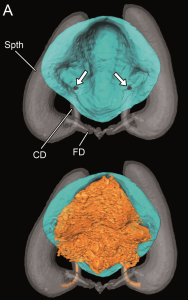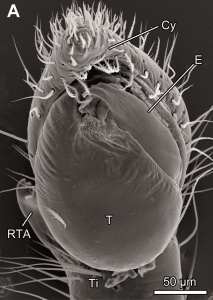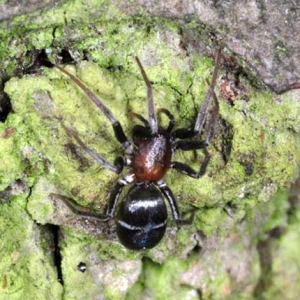
It’s no surprise that mating can be complex for male cannibal spiders. Those that avoid becoming dinner for their prospective mates have a trick of their own; they can plug the female’s genital tract, preventing her mating with other males. However new research, published today in BMC Evolutionary Biology, suggests that even here it is the female who remains in control.
The mating game
Finding a mate can be a tricky business. Throughout the animal kingdom the struggle to secure mates and produce offspring (that is, sexual selection) shapes evolution. We tend to focus on the more obvious, pre-copulation, type of sexual selection, like the bright plumage and complex songs of birds, or two rutting stags fighting for the attention of a doe.
However much of sexual selection, at least in species where females mate with more than one male, goes on after mating has actually occurred. A male can mate with a female, but if other males also copulate with her, whose sperm will fertilise her eggs? Within a female’s reproductive system, sperm competition can occur between the sperm of the various males she has mated with.
This has important implications for males. A male could mate with a female and still find himself fathering very few (if any) of her offspring. What to do about this problem?
Plugging the gap
A common male tactic is to block access for other males by plugging the female’s reproductive tract following copulation. Such plugs can be made from secretions produced by the male reproductive organ, from parts of the male’s body or even, in extreme cases, the male himself.
Whatever the tactics used by males, they seem like bad news for females. Being prevented from mating with another male of her choice (perhaps a more attractive male) would seem to go against her interests.
Does this mean females are just passive pawns in the male mating game? Maybe not, suggests new research on cannibal spiders, published today in BMC Evolutionary Biology; females could actually be controlling this process for their own benefit.

Cannibal spiders
Mating is more than tricky for cannibal spiders; it’s downright life threatening. As the name suggests, mating in these spiders is often terminated by the female eating the male.
Micaria sociabilis, a cannibal spider found in much of Europe, is a little different in that males, presumably in the spirit of equality, will sometimes eat females during mating. Like other cannibal spiders though, males have to compete with rivals potentially mating with the same female. They have evolved the ability to manufacture mating plugs using secretions from their pedipalps (the fang like structures either side of the spider’s mouth).
Researchers, led by Stano Pekár at Masaryk University in the Czech Republic and Gabriele Uhl at the Ernst Moritz Arndt University of Greifswald in Germany, looked to determine why some Micaria sociabilis males successfully plug females during mating, while others fail in the attempt.
Love in a petri dish
As small spiders (an average body size of just 3mm), Micaria sociabilis are easily caught in the wild and transferred to laboratory conditions. For these experiments, a male and female spider were placed in a petri dish and the resulting mating behaviour filmed for later analysis.
Unlike many spiders, Micaria sociabilis shows no kind of courtship behaviour. If the male is interested, he will simply mount the female from the front, clamber over her back and attempt to insert one of his pedipalps into her copulatory organs. Who say’s romance is dead?
The researchers measured the amount of time males spent copulating with females, who terminated the copulation (the male gave up or the female shook him off) and whether the male successfully plugged the female.

Plugged or unplugged?
When mating with unplugged females, males successfully produced a complete plug (one which was still fully blocking the female’s reproductive tract 24 hours later) in 40% of the mating trials; in another 20% of trials the male made an incomplete plug that did not persist for more than one day after copulation.
Notably, the ability to successfully produce a plug was linked to the duration of copulation; when successful, males copulated with the female for an average of more than two hours, whereas when no plug was made average copulation time was a mere 20 minutes.
In 99% of these trials it was the females who terminated copulation (by struggling vigorously). Essentially, males don’t give up on trying to mate with an unplugged female. Instead, it is females that control the termination of copulation.
Females in control

The researchers suggest that if females are largely controlling whether a willing male has the time needed to produce a stable plug, this behaviour could be a cryptic form of sexual selection. Females are assessing the quality of the male attempting to mate with them and, if they like what they see, they give him the time needed to plug her reproductive openings, ensuring he will father more of her offspring.
Exactly what criteria females use to judge a male are unclear. Male body size was not correlated with female response and males do not engage in any pre-copulatory courtship behaviour by which females could assess them. The researchers speculate that females assess a male’s skills during the early phase of copulation and decide based on this whether to allow them to continue long enough to make a plug.
Even beyond the risk of ending up as dinner for your prospective partner, mating is a complex game for cannibal spiders. This new research suggests that rather than being passive players in the game, it is females that determine the outcome. It seems the best way for a male cannibal spider to tell that a female likes him is that she gives him enough time to make her all his own.
Comments